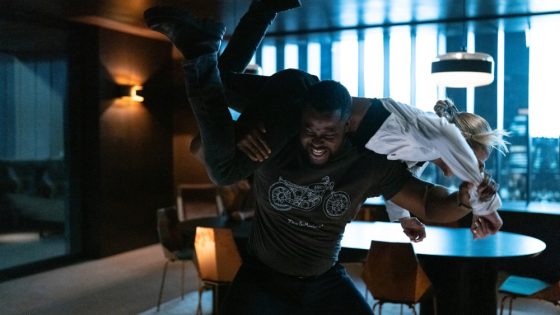When you think about your favorite action flick, you probably can’t name the stunt performers behind the larger-than-life fight sequences and explosions. Nor can you identify the budget-conscious producers who keep the shoot on schedule or the harried personal assistants juggling 15 things (including their boss’ coffee order) all at once.
You rarely see those names up in lights — in fact, streaming services oft encourage viewers to skip past them as the credits roll and roll.
That’s why the stars of “The Fall Guy,” including Winston Duke, Emmy winner Hannah Waddingham and Oscar nominee Stephanie Hsu, are saluting the thousands of people who work behind the scenes to make movie magic.
“We’re allies of the stunt community, and we make this movie to try to bring you in as allies as well,” Duke tells Variety, sitting alongside Waddingham and Hsu as they promote the action-packed blockbuster from stuntman-turned-filmmaker David Leitch.
Read on as the trio talk training to take the hits and shout out the stunt performers who stepped in when they couldn’t. Plus, they share what it will take to see a stunt category included at the Oscars.
You’re all very experienced in this stunt realm, but I want to take a minute to shout out your stunt doubles. What is the craziest stunt that your character had that you weren’t allowed to perform?
HANNAH WADDINGHAM: I was allowed to do it, but I chickened out. Fabulous Chanique Grey — and I can’t say her name enough — I was meant run down this sandy bank before I throw a gun in the face of the sound man. I had had a back operation two years previously and suddenly was like, “Chanique, can you make me look good, please?” She was so gorgeous and so supportive. Honestly, I can’t shout her name high enough.
WINSTON DUKE: It’s one that I did do and needed to recover for, like, three days after the rehearsal, which gave me more respect for my stunt double [Eric Mbanda]. There’s a missile kick in our movie. In the rehearsal, I was doing it on pads and it took me three days to recover from just falling over and over and over. My guy did it on the ground. He did it on just, like, Earth and I loved him for it. I couldn’t have done it.
STEPHANIE HSU: I just want to give a quick shout out to Jean Claude, the dog in our movie who also had a stunt double and it was a puppet. Jean Claude was not allowed to bite the man in the garbage truck. His puppet had to do it and the animal trainers were puppeteering a puppet through the garbage bin. I have a really incredible photo of it. Shout out to Jean Claude’s puppet stunt double.
WADDINGHAM: Smoke and mirrors all the way.
That’s the beauty of this movie — highlighting all the people behind the scenes. But I want to touch on something you just mentioned with the pads and the training. That also sometimes plays into the costumes. When you’re doing these stunts, how much padding did you have to wear and where?
DUKE: Always knee pads, because you have these level changes, and it can happen at any time. Back padding for some of the falls I did do. And some in the crotch area because things can get a little wily.
WADDINGHAM: Knee pads, yes. You just have to get over the vanity thing. You don’t want a bulky knee, but you also want to keep your knees intact.
My [stunt] was up in the helicopter. Chanique was a little protective bird in my ear telling me how to conduct myself when the helicopter’s moving around on that arm. It was really aggressive. All my stuff was trying to lean back. She was like a guardian angel with me during that three-day helicopter section.
HSU: I was wearing a mini skirt, so there was no room for knee pads; that would be too visible. But sometimes it’s kind of fun to get a little banged up. I think that’s how you know I’m a novice, because I’m like, “Yeah, I’m gonna, like, actually kick him really hard.” I remember going home being like, “I’m purple on my legs.” But artists are masochists.
WADDINGHAM: But god, you looked badass! My lord.
Stephanie, what is the key to a great driving fight scene? Not to mention you’re doing it with “The Driver” (Gosling’s character from “Drive”).
HSU: It sounds cliché, but it really is such a testament to our incredible stunt team and our stunt coordinators, who train the bejesus out of us to make sure that not only we’re safe, but also that we’re doing a fight that looks as epic as it wants to feel. That’s the secret. The people who are behind the scenes are there to support us, to make us all thrive.
WADDINGHAM: You very much feel the fact that it is, joking aside, absolute “safety first.” They bring you down and root you and tether you because it is extremely dangerous what they do. We have to get out of the way and just pause for a moment and let them focus. It was really humbling watching them.
DUKE: The fight personality, the fight profiles are so different in the film. Ryan fights completely different than my stuntman character Dan Tucker, and Dan and Colt fight completely different than Stephanie’s assistant character. I find there’s so much specificity, even in the fight scenes; it always moves the story forward and it tells additional story. It tells all these additional stories in a non-didactic way where you understand that character so much more based on that movement. It’s a really brilliant, understated storytelling device.
Stephanie Hsu (as Alma Milan) and Jean Claude in “The Fall Guy.”
Universal Pictures
What has that experience of understanding your fight style been like for you as actors? Winston, you’ve had lots of experience doing your own stunts for Marvel. What types of stunt work come naturally to you versus things you’re not as good at?
DUKE: It was great to reconnect with some old personalities. Jojo [Jonathan Eusebio] was part of the “Black Panther” stunt team, so he actually knew a lot of my movements and a lot of my capabilities, and we prepared a lot of really cool vignettes and then applied some of those to each scene as they were necessary. It gave us the opportunity to tell more story and add a little bit more onus to each scene.
WADDINGHAM: They’re very clever at eking out your particular strengths and they go in on that with you so that you are being pushed, but you still have a foot in your comfort zone of what you’re capable of.
Stephanie was talking earlier about the choreography of it all, from the world that she and I come from in stage. I found that on [another project] they really lent into the repetition of the movement — your bones and your muscles being used to that movement, so it meant that coming to this, I really felt supported by the team like saying, “Always tell us what you’re comfortable with. And then we’re just going to nudge you through the door a little bit more.”

Hannah Waddingham (as producer Gail Meyers) in “The Fall Guy.”
Eric Laciste
To that point of the stunt teams’ professionalism and that real excellence, what is it going to take to get a stunt category at the Academy Awards? What have you heard from the stunt community?
WADDINGHAM: Hopefully this will help get it there.
HSU: This movie will, hopefully. It is a pretty loud and joyous…
WADDINGHAM: Surely it can’t be ignored anymore.
DUKE: As to your question of what it will take — it’s organization and shared allyship. We’re allies of the stunt community, and we make this movie to try to bring you in as allies as well, as consumers and as movie goers, and people who participate in your own way in filmmaking. There could be no movies without the audience and we need you to amplify the voice of these folks as well. It takes allyship to get this to change.
WADDINGHAM: If anyone’s going to be listened to, surely, it has to be the captain of the ship – and that’s David Leitch.
HSU: It is acknowledging that [stunt work] is a true art form. Especially now, when so much can be solved by VFX or special effects, the old school way of making action films is choreography, is design, is building out the rigs. Honoring that I think is going to keep that that culture and that history alive even longer.
DUKE: Hear, hear!
Source Agencies



